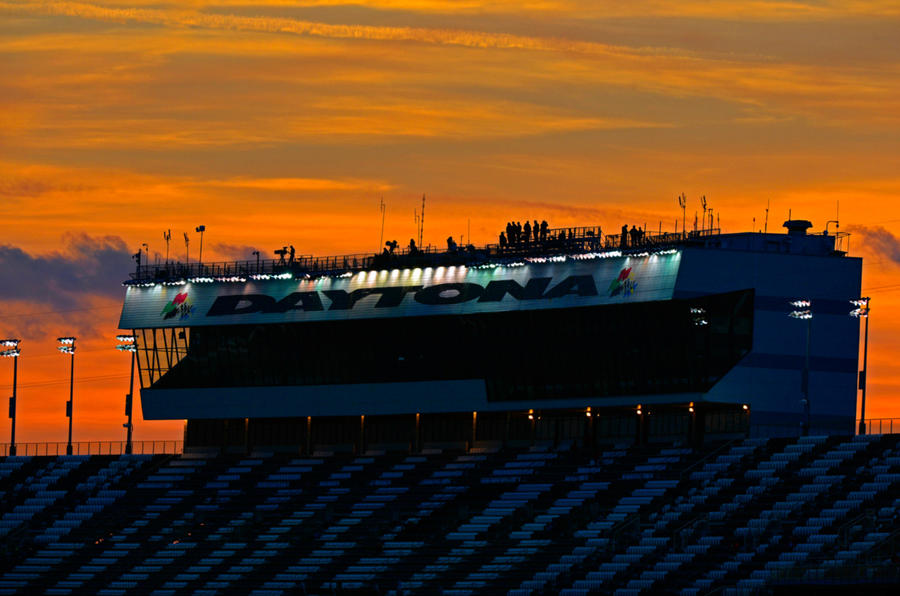Before the recent Daytona 500, the folk in Florida announced plans to upgrade the spectator facilities at Daytona International Speedway. It is the biggest of the NASCAR tracks and has a seating capacity of nearly 170,000. The problem is that it has not been upgraded for a long time.
The primary goal of the work will be to improve the fan experience. Already almost the entire circuit can be seen from any of the seats, but these are rather old and not very comfortable. The plan is also to add an additional tier of seating on top of the existing grandstands, which are a mile long. There will be new VIP suites.
In addition the speedway asked Rossetti Architects of Southfield, Michigan, to develop public spaces into destinations and by doing so encourage visitors to come earlier and stay longer (and thus spend more money). The result is an interesting series of what are called “neighbourhoods” inside the grandstands.
There will be 11 of them, including a central one which will be a historical exhibition. The other 10 will provide space for fans to meet, eat, shop and visit “the rest rooms”. Each of these areas will have large video screens so that the spectators do not miss any of the action. The plan also includes the installation of 40 escalators in five “injector” zones, which will make it much easier for the fans to get to their seats and to the various concourses.
Contrast this with the recent announcement at Silverstone that the track is not going to use the expensive new pit and paddock complex, called “The Wing” for this year’s British GP MotoGP event because the fans prefer the older facilities.
"Until we have the funds to build a bridge or tunnel connecting the outside of the circuit with The Wing, the old paddock is a more accessible facility for fans," explained Richard Phillips, the managing director of Silverstone.”
The two announcements highlight the differences between the racing circuits in the United States and in Europe. The US facilities have money; the Europeans do not. The primary problem is that while tracks can be “nice little earners” that stops if they want to run Formula 1 races. The problem is the annual fee demanded by the Formula One group for the right to hold an event, coupled with the rights than must be signed away.




Join the debate
Add your comment
You can get a perfectly
You can get a perfectly decent seat at a big NASCAR event, say the Texas 500, for $35, but you can pay upwards of $1,000 for seats in settings like "The Victory Lane Club". Indy 500 starts at around $100 but the sky, or skybox, is the limit. With 100-250,000 fans, and multi-day packages, it adds up.
F1 drivers are royalty and the fans are serfs. It's much more democratic in the US, with much better access to the drivers. However, while there is no aristocracy in the US, there is absolutely a plutocracy and many Americans wouldn't dream of rubbing shoulders with the "trash in the cheap seats".
The money comes from the fans, television, advertising and concessions (I don't think US motor racing venues get much of the civic-funded financial incentives that basketball and other team sports seem to wangle.) What matters is how the money is divided, specifically how much stays in the venue, and it seems to me that in F1 too much money leaves the track and disappears into Bernie's offshore labyrinth. I got very excited when some of the big engine makers talked about pulling out of F1 and starting their own race series, but we seem to be back to the status quo.
Bernie Ecclestone
Am I the only one who has the urge to punch this man in the face every time I see it on T.V. or in print?
Whilst people keep paying, nothing will change
Firstly it was a terrible tragedy what happened at Daytona, and thoughts go out to all those affected. However it's encouraging to see that a cohesive project to deliver facility improvements which should meet fans needs has been penned rather than a meagre plan to increase the depth of the carpet pile within the facilities corridors of power.
With the tasty ticket prices (and I don't just mean F1, but also Moto GP, BTCC), and the heavy levies placed on the catering and merchandise tents you'd expect there to be some cash in the pot to make the venue into something approaching what it needs to be (for it's paying customers).
I suppose most of the planned changes at outdated motorsport circuits are made to meet the requirements and 'needs' of the likes of the illustrious Mr. Ecclestone and entourage, and actually not the paying punter. The net result is that (as highlighted re: the Paddock Complex) the facilities are not fit for purpose for the majority of users as the changes are crafted to address the ego's of the overpaid few.
Yet again, capitalism fails the majority whilst rewarding the absolute few. OK, it puts Bernie into 4th place in the UK rich list which is nice, but the upshot is that Joe Public gets the privilege of paying well over 200 sheets a head for a plastic seat to watch a bit of pre-scripted motorsport, a horse burger, and the opportunity to urinate in almost third world levels of squalor. What's not to like Yet we still keep paying. While we do it won't change.
Yet we still keep paying. While we do it won't change.